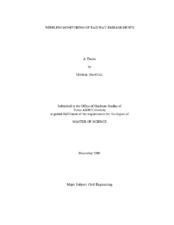| dc.description.abstract | Landslides are one of the most dangerous geological hazards. In the United
States, landslides cause a damage of $ 3.5 billion and kill 25 to 50 people annually.
Shallow landslides occurring near any transportation facilities (railways and highways)
can cause economic loss and disturbance of services which lead to indirect economic
loss. It also increases the maintenance cost of those facilities. Hence, facilities located
near a shallow landslide prone area should be monitored so as to avoid any catastrophic
damages. Soil moisture and movement of the soil mass are prime indicators of potential
shallow slide movements.
This assessment of wireless instruments considers a variety of devices ranging
from devices for monitoring tilt and moisture at specific points in the soil mass to ground
penetrating radar (GPR), which can give indications of moisture accumulation in soils
over a wide spatial extent. For this assessment study, a low cost MEMS accelerometer
was selected for measuring tilts and motions. And EC type soil moisture sensor was
selected to measure soil moisture content of embankments. The instrumentation of railway embankments works effectively and cheaply when a suspected problem area has
already been identified and monitoring is needed over a limited spatial extent. This
makes the monitoring system highly localized which often fails to cover potentially new
failure prone areas. It is not feasible to use this approach to monitor soil conditions along
the entire alignment of the railway. Therefore, another approach, GPR, is defined and
explained in this study. GPR measures the dielectric constant value for any given
material including soils. In soils, the dielectric constant value depends on the volumetric
amount of water content present in a soil. Due to moisture infiltration, there is a
reduction in suction value on embankment which indicates a decrease in shear strength
of slope. Therefore, a correlation between suction and dielectric constant value is
formulated in this study using Complex Refractive index model/Time propagation
(CRIM/TP) model for soils. To validate this theoretical correlation, a laboratory study
was conducted on pure kaolinite and on normal soil. For pure kaolinite this correlation
proves beneficial while, for other type of soil, the correlation was off due to the
limitations in filter paper test to measure suction below 2.5pF. | en |


